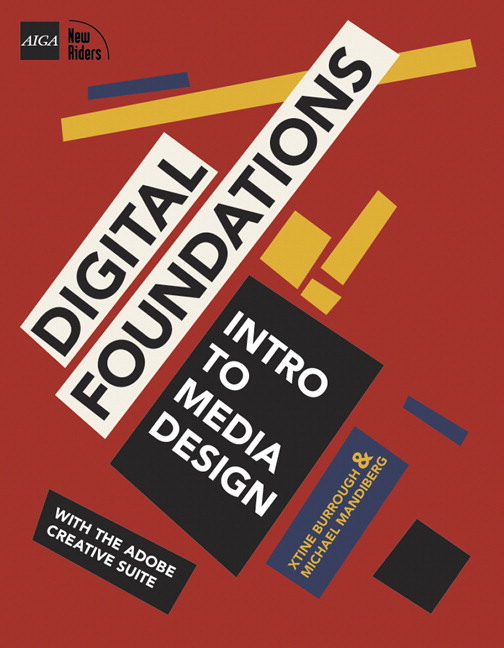Difference between revisions of "Main Page"
| Line 1: | Line 1: | ||
| + | ==From Digital Foundations== | ||
| + | <table class="infobox"> | ||
| + | <tr> | ||
| + | <td>[[Image:Finalcover_pearsonsite.jpg|Finalcover_pearsonsite.jpg]]</td> | ||
| + | </tr> | ||
| + | </table> | ||
[[Image:Bauhaus_plus.gif|Bauhaus_plus.gif]] | [[Image:Bauhaus_plus.gif|Bauhaus_plus.gif]] | ||
| + | <br> | ||
<br>Digital Foundations: Introduction to Media Design with the Adobe Creative Suite integrates the formal principles of the Bauhaus Basic Course into an introduction to digital media production with the Adobe Creative Suite. | <br>Digital Foundations: Introduction to Media Design with the Adobe Creative Suite integrates the formal principles of the Bauhaus Basic Course into an introduction to digital media production with the Adobe Creative Suite. | ||
Revision as of 11:23, 3 January 2013
From Digital Foundations
 |

Digital Foundations: Introduction to Media Design with the Adobe Creative Suite integrates the formal principles of the Bauhaus Basic Course into an introduction to digital media production with the Adobe Creative Suite.
Textbooks and software manuals on today’s market do not include art and design history or visual principles. This book synthesizes historical examples and traditional studio foundation exercises into smart, well-paced software exercises. See it for yourself in Chapter 5, where we explore Illustrator's Color Picker through Joseph Albers’ color exercises.
Digital media texts about Adobe Creative Suite, whether they are “Bibles”, “For Dummies” or “Classroom in a Books”, focus on tools and production tips. Digital Foundations is the only textbook that teaches visual skills through production tools. Look at our Table of Contents. It is organized by visual topics, including symmetry, line art, tonal scale, elements of motion, and more. Digital Foundations is not specifically for dummies or classrooms. It was made for self-learners, artists, designers, as well as classroom applications. We wrote this book for our classrooms as well as for our parents!
The exercises in all twenty chapters have been tested and proven in our classrooms. We plan to use the book in multiple courses including foundations media design, introduction to graphic design, introduction to web design, and graphics communications.
Introduction: Read_Me!
This book was written by two artists who also happen to be educators teaching studio foundation classes in digital art and design. While teaching classes that meet in software laboratories, we noticed that many of our students expected to learn software but gave little consideration to aesthetics of history. A typical first day question might be, "Are we going to learn Photoshop in this class?"
At first we were tempted to oblige our students' thirst for so-called practical knowledge, but we recognize that in the absence of the visual, theoretical, and historical frameworks practical knowledge is practically useless. To teach our classes we used the very best of the software training manuals, and supplemented them with all the visual and historical material that was missing. We have tired of fighting against these books as we attempted to reframe the technical learning inside of visual principles and historical examples.
After settling on a book that doesn’t really encapsulate a class for years, we finally decided to write the book that we think all introductory media design students should be using. For us a student anyone learning, whether traditional and working towards a degree in art, communication, graphic design, illustration, and so on, or if she is a self-taught found-it-on-the-bookstore-shelf learner.
In the twenty chapters that follow, we have created small bites of history, followed by visual references, and then digital exercises that explore Adobe’s Creative Suite in a manner that extends learning design principles to the realm of the software demonstration.
Bauhaus
One way to think of this book is a mashup of the Bauhaus Basic Course and the Adobe Creative Suite. We are taking the visual principles and exercises from the Bauhaus Basic Course and teaching them in the Adobe Creative Suite.
The Bauhaus was an influential art, design and architectural school in Germany. It operated from 1919 to 1933, during which time it transformed art education, through its integration of art, craft, architecture and design, its emphasis on modern materials, and the creation of the Basic Course. The Basic Course was a year long course in which first year students learned composition, color theory, and how to use a variety of basic materials. When many of the instructors fled Nazi Germany, arriving in the United States and other countries, they brought this education model with them in the guise of the Studio Foundation course.
This book takes its inspiration from the Bauhaus model, transforming those traditional lessons into the digital exercises in the Adobe Creative Suite.
Operating Systems & Version Numbers
This book is written around the core principles of the Adobe Creative Suite design applications. The latest bells and whistles are not that important, and frankly, they are usually a marketing tool. What matters are the core principles that do not change from version to version, or operating system to operating system.
While we have written this book using Adobe Creative Suite 3 on Mac OS 10.5, we have written it to be version independent. We expect that this book will still be just as useful if you were using Adobe Creative Suite 2 on Windows XP, Photoshop 7 on Mac OS 9, or future versions of the software that will be released in the years to come.
Within this book we refer to all shortcuts using the MacOS protocol. If you are using this book with Windows, simply translate the Command key (or CMD) to the Control key (CTR) on your keypad and the Option key (OPT) to the Alt key (ALT). Everything else remains the same.
We just signed a contract with New Riders/AIGA Design Press. The contract specifies that the book and all of the exercises will be licensed under Creative Commons (CC+ BY-NC-SA). This is the first Creative Commons contract issued by New Riders, their parent company Peachpit, their grandparent company Pearson, or their great-grandparent company Prentice Hall.
We are approximately 66% to 75% finished with the writing process, and closing in fast.
We have a formal "all in" date in October, and hope to have it in print by the end of the Fall Semester for Spring 09 adoption.
You will be able to order a copy of the book here.
If you are an instructor interested in adopting this book in your course, please request a free review copy through Pearson's website.
If you are a member of the press, and would like a copy to review, are interested in scheduling an interview, or excerpting from the book please contact press@peachpit.com





